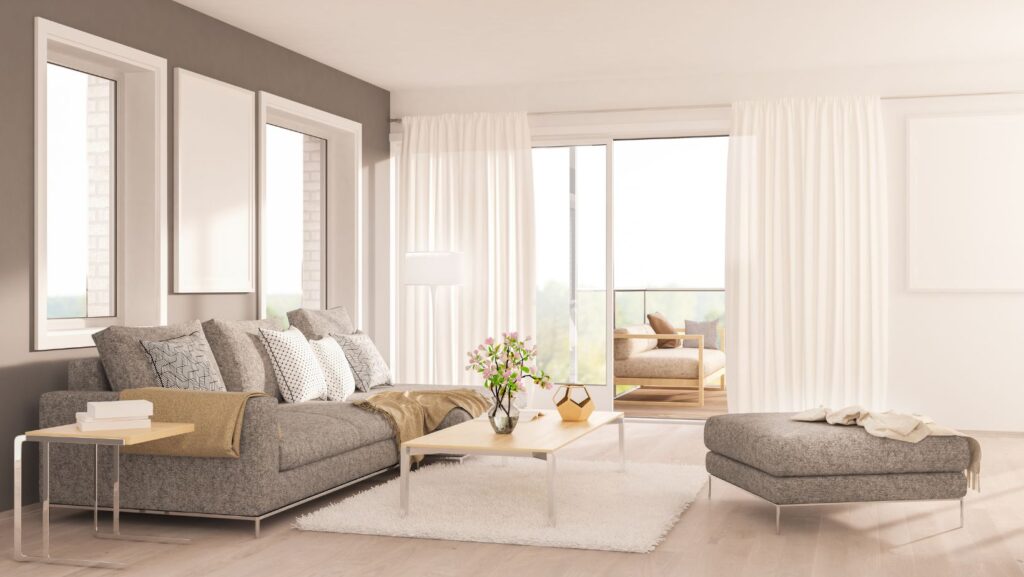Embracing a living room minimalist design doesn’t mean tossing out all your things and living in a stark, white box. It’s about functionality, simplicity, and purposeful living. This trend pairs down the elements of a space to its essentials, removing clutter and emphasizing clean lines. Homeowners are drawn to this aesthetic as it embodies tranquility and order in an often chaotic world.
When you’re going for a minimalist look in your living room, every piece counts. Furniture should be streamlined with no frills or unnecessary details. Decorations are kept to a minimum – think one or two statement pieces instead of shelves full of knick-knacks. The color palette leans towards monochromatic tones with pops of color used sparingly.
Living Room Minimalist
Adopting a living room minimalist design can transform your space into a serene and stress-free environment. It’s all about simplifying the decor while maintaining aesthetics and functionality. A minimalist living room doesn’t mean you’ll have an empty, cold space. Instead, it’s a refined expression of simplicity that prioritizes quality over quantity.
So, what exactly does a minimalist living room look like? Picture clean lines, neutral color palettes, and clutter-free surfaces. Furniture should be minimal yet functional – think streamlined sofas, sleek coffee tables, and unadorned shelves. Artwork is often limited to one statement piece that anchors the entire design scheme.
One key element of this style is strategic use of space. Open floor plans are common in minimalist design as they facilitate clear sightlines and an airy atmosphere. It’s not just about what you put in the space; it’s also about embracing negative spaces without feeling compelled to fill them up.
High-quality materials play a crucial role too. A minimalist living room will typically feature natural materials such as wood or stone for flooring or furniture pieces. These elements add texture without disrupting the calming aesthetic.
Lighting is another critical aspect of minimalist design; natural light is highly favored for its ability to brighten up spaces without adding visual clutter. Clear windows with simple treatments allow sunlight to flow freely throughout the day.
Here are some quick tips on achieving a minimalist living room:
- Stick to a monochromatic or neutral color palette
- Keep surfaces free from unnecessary items
- Choose furniture with clean lines
- Include only necessary and functional items
- Embrace open spaces
In essence, creating a minimalist living room isn’t complicated but requires thoughtful selection of every item that goes into your space.

Key Elements of Minimalist Design
When it comes to the minimalist design, especially in a living room, two key elements play a pivotal role: simplistic furniture and a neutral color palette. They’re what make this style so appealing and timeless.
Simplistic Furniture
Minimalism isn’t about removing comfort from your life; rather, it’s about prioritizing functionality over ornamentation. This principle is evident in the selection of furniture for a minimalist living room. Sofas, chairs, tables – they all have clean lines that don’t overpower the space. It’s more than just choosing pieces with simple designs; it’s also about their placement within the room.
Think less clutter but more organization. The idea is to create an open and breathable space where each piece has its purpose. For instance:
- A sleek coffee table serves as both a place for your morning cup of joe and storage for books or magazines.
- A streamlined sofa offers comfortable seating without taking up too much visual real estate.
- Wall-mounted shelves give you ample storage without compromising floor space.
The goal is to eliminate unnecessary elements while creating an environment that promotes relaxation and conversation.

Neutral Color Palette
Color plays an integral role in minimalist design. More often than not, minimalists lean toward neutral tones – think whites, grays, beiges – as these colors tend to evoke calmness and serenity.
But why stick solely with neutrals? Well:
- Neutral colors help maintain focus on essential elements like your furniture or artwork.
- They make small rooms appear larger due to their light-reflecting properties.
- Neutrals provide an excellent backdrop against which pops of color can stand out beautifully.
Incorporating accent colors through accessories can add character without overwhelming the simplicity of the space. An indigo throw pillow here or a ruby-red vase there could serve as vibrant focal points amidst the neutrality.
Ultimately, when styling your living room minimalist style, remember that less is more. Whether you’re selecting furniture or deciding on your color palette, keep in mind that the goal is to create a space that’s comfortable, functional, and free from unnecessary clutter. It’s about creating an environment where you can live with less while experiencing more.
